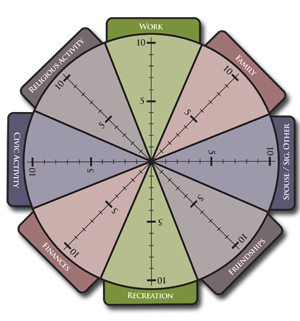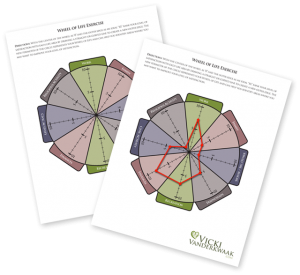The Wheel of Life is a tool that can be used to make an overall assessment of satisfaction in the significant areas of a person’s life. The Wheel of Life easily provides a big-picture snapshot of where someone is feeling satisfied or not so satisfied on any given day.
The Wheel of Life contains eight pie-like sections that represent different areas of a person’s life. In this Wheel of Life, the eight areas of life include: Work, Family, Spouse/Sig.Other, Friendships, Recreation, Finances, Civic Activity, and Religious Activity. The section labels can be changed if needed, to better represent the specific circumstances of a client’s life. For example, some clients may wish to disregard one of the areas listed here, or add a new section entirely. Some may prefer to start with a blank wheel and label their own pie-like sections right from the start.
It is very important to realize that for EACH of the eight areas featured on The Wheel of Life, there are numerous dimensions of a person’s overall well-being that can be identified and explored through coaching. For example, while exploring a person’s level of satisfaction in the area of Work, or in the area of Family, coaching will likely invite questions about how the client’s choices in that particular area of life are facilitating his/her physical, emotional, or spiritual, well-being. As a client grows more aware of what choices promote a sense of overall well-being in a particular area of life, he/she is better equipped to make ongoing informed healthy choices in that area of life and in other areas of life as well.
When using the Wheel of Life, the client is asked to look at each area in the wheel and rate his/her level of satisfaction using a 0-10 scale (with 0 being at the center of the wheel and 10 being the outside edge of the wheel). A finished wheel might look something like this:
When a client wants to grow their level of satisfaction in a particular Wheel of Life area, the coaching process will revolve around this primary question: “What would it take for me to be more satisfied in this area? Physically? Emotionally? Spiritually?” As these question are explored, clients often come to a new understanding of what true satisfaction is for them, or what their true values are.

